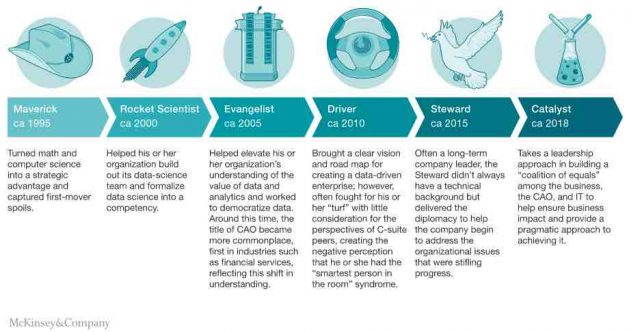I really like a recent article by McKinsey about Rebooting Analytics Leadership and Moving Beyond the Math. Like many, I see a lot of opportunity with data and analytics. I believe insights in context will bring more value to business than any previous iteration of report, self-service reporting, visualization, etc. The combination of AI, API’s, Visualization, and Multiple Channels brings so much opportunity to finally allow companies to gain understanding.
McKinsey chose to focus on Chief Analytics Officers (CAO) and how that position has changed from Maverick to Evangelist and finally to Catalyst.

The reality is that any analytics leader faces key challenges around the range of data, the lack of support, and unrealistic demands.
The reasons for low success rates to date are numerous, as CAOs face a barrage of headwinds—from data silos and rising data risks to leaders and front lines resistant to a new way of data-driven decision making—while experiencing some of the lowest tenures among their peers (about two to three years). One analytics leader told us, for example, that while his organization hired him to create a data and analytics function that could scale to drive growth, progress was constantly derailed, as his team was forced to spend outsized time generating basic reports for narrowly focused business leaders.
Todays Challenges
Today, the challenges continue and many cases get even more complex. Here’s what McKinsey had to say on the new challenges
- AI is viewed as table stakes (and yet many have only begun to think about them)
- Expectations are rising, especially among the digital natives
- Personalization is expected
- Data Privacy will only become more important……and onerous
- Key leaders will still dive into the rabbit hole and demand 500 reports rather than focus on true insight. (OK, that’s partially mine based on what I continue to see)
What To Do?
The new CAO will probably be less of a techie and more of a “catalyst”. He or she will focus on bringing business, IT, and Analytics together. It will include:
- Recognizing that while a technical background is critical, there’s much more to driving success. “While it’s critical to get the math right, just getting the math right doesn’t drive the change,” said one insurance analytics leader. “You need the technical background to establish credibility, but the job is less about the technical aspect and more about employee development, resource allocation, vision setting, and leadership to manage the pace of change.”
- Putting business value front and center. The same insurance analytics leader stated: “It’s gaining the trust of business-unit leaders by helping them to understand how the models influence business impact and, ultimately, drive profit and loss. That’s what they’re interested in.”
- Spending an outsized proportion of time on communicating with the CEO and other C-suite leaders to maintain their support. For example, a financial-services analytics leader set up monthly operational committee meetings with his COO, CIO, CFO, and business-unit heads to set a shared vision and review priorities, progress, new value-creation opportunities, and investment needs. Throughout the month, he met separately with committee members, along with other company leaders, to maintain alignment and buy-in. He estimated that more than one-third of his time was spent on executive alignment and strategy.
My Take
So to bottom line, a true analytics leader will focus on business value. He or she will also focus on meeting the true needs of all types of users:
- Execs, business leaders, line of business users, IT, field service, etc.
- User type: simple insight in the context they work, curious power users willing to spend some time getting at the insights, Data Scientists delving into previously unknown insights
- AI and their data sets to enable more of it all
That means you have to do everything you see from McKinsey and more. It probably means a team with key lieutenants focusing on things like:
- communication to more than just the C-Suite. The C-Suite is important. You just can’t stop there.
- Creating usable self-service tools.
- Working with various types of users to push the data to where it’s needed (Insight in Context)

